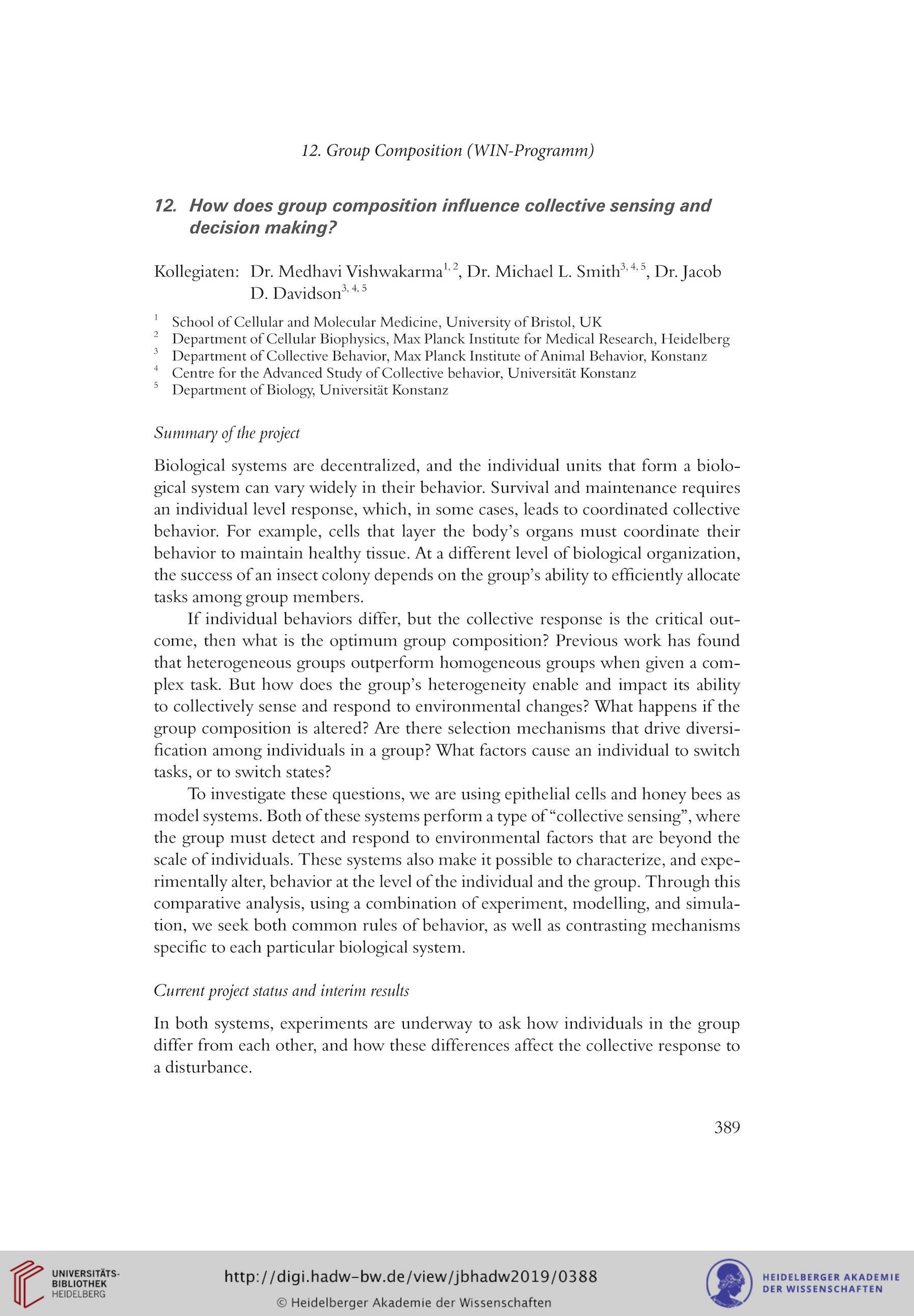12. Group Composition (WIN-Programm)
12. How does group composition influence collective sensing and
decision making?
Kollegiaten: Dr. Mcdhavi Vishwakarma1’2, Dr. Michael L. Smith3’4’5, Dr. Jacob
D. Davidson3,4,5
1 School of Cellular and Molecular Medicine, University of Bristol, UK
2 Department of Cellular Biophysics, Max Planck Institute for Medical Research, Heidelberg
3 Department of Collective Behavior, Max Planck Institute of Animal Behavior, Konstanz
4 Centre for the Advanced Study of Collective behavior, Universität Konstanz
Department of Biology, Universität Konstanz
Summary of the project
Biological Systems are decentralized, and the individual units that form a biolo-
gical System can vary widely in their behavior. Survival and maintenance requires
an individual level response, which, in some cases, leads to coordinated collective
behavior. For example, cells that layer the body’s organs must coordinate their
behavior to maintain healthy tissue. At a different level of biological Organization,
the success of an insect colony depends on the group’s ability to efficiently allocate
tasks among group members.
If individual behaviors differ, but the collective response is the critical out-
come, then what is the Optimum group composition? Previous work has found
that heterogeneous groups outperform homogeneous groups when given a com-
plex task. But how does the group’s heterogeneity enable and impact its ability
to collectively sense and respond to environmental changes? What happens if the
group composition is altered? Are there selection mechanisms that drive diversi-
fication among individuals in a group? What factors cause an individual to switch
tasks, or to switch States?
To investigate these qucstions, we are using epithelial cells and honey bees as
model Systems. Both of these Systems perform a type of “collective sensing”, where
the group must detect and respond to environmental factors that are beyond the
scale of individuals. These Systems also make it possible to characterize, and expe-
rimentally alter, behavior at the level of the individual and the group. Through this
comparative analysis, using a combination of experiment, modelling, and Simula-
tion, we seek both common rules of behavior, as well as contrasting mechanisms
specific to each particular biological System.
Current project Status and interim results
In both Systems, experiments are underway to ask how individuals in the group
differ from each other, and how these differences affect the collective response to
a disturbance.
389
12. How does group composition influence collective sensing and
decision making?
Kollegiaten: Dr. Mcdhavi Vishwakarma1’2, Dr. Michael L. Smith3’4’5, Dr. Jacob
D. Davidson3,4,5
1 School of Cellular and Molecular Medicine, University of Bristol, UK
2 Department of Cellular Biophysics, Max Planck Institute for Medical Research, Heidelberg
3 Department of Collective Behavior, Max Planck Institute of Animal Behavior, Konstanz
4 Centre for the Advanced Study of Collective behavior, Universität Konstanz
Department of Biology, Universität Konstanz
Summary of the project
Biological Systems are decentralized, and the individual units that form a biolo-
gical System can vary widely in their behavior. Survival and maintenance requires
an individual level response, which, in some cases, leads to coordinated collective
behavior. For example, cells that layer the body’s organs must coordinate their
behavior to maintain healthy tissue. At a different level of biological Organization,
the success of an insect colony depends on the group’s ability to efficiently allocate
tasks among group members.
If individual behaviors differ, but the collective response is the critical out-
come, then what is the Optimum group composition? Previous work has found
that heterogeneous groups outperform homogeneous groups when given a com-
plex task. But how does the group’s heterogeneity enable and impact its ability
to collectively sense and respond to environmental changes? What happens if the
group composition is altered? Are there selection mechanisms that drive diversi-
fication among individuals in a group? What factors cause an individual to switch
tasks, or to switch States?
To investigate these qucstions, we are using epithelial cells and honey bees as
model Systems. Both of these Systems perform a type of “collective sensing”, where
the group must detect and respond to environmental factors that are beyond the
scale of individuals. These Systems also make it possible to characterize, and expe-
rimentally alter, behavior at the level of the individual and the group. Through this
comparative analysis, using a combination of experiment, modelling, and Simula-
tion, we seek both common rules of behavior, as well as contrasting mechanisms
specific to each particular biological System.
Current project Status and interim results
In both Systems, experiments are underway to ask how individuals in the group
differ from each other, and how these differences affect the collective response to
a disturbance.
389




